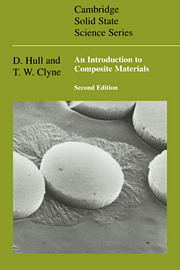Book contents
- Frontmatter
- Contents
- From the preface to First Edition
- Preface to Second Edition
- 1 General introduction
- 2 Fibres and matrices
- 3 Fibre architecture
- 4 Elastic deformation of long-fibre composites
- 5 Elastic deformation of laminates
- 6 Stresses and strains in short-fibre composites
- 7 The interface region
- 8 Strength of composites
- 9 Toughness of composites
- 10 Thermal behaviour of composites
- 11 Fabrication
- 12 Applications
- Appendix: Nomenclature
- Author index
- Subject index
7 - The interface region
Published online by Cambridge University Press: 05 June 2012
- Frontmatter
- Contents
- From the preface to First Edition
- Preface to Second Edition
- 1 General introduction
- 2 Fibres and matrices
- 3 Fibre architecture
- 4 Elastic deformation of long-fibre composites
- 5 Elastic deformation of laminates
- 6 Stresses and strains in short-fibre composites
- 7 The interface region
- 8 Strength of composites
- 9 Toughness of composites
- 10 Thermal behaviour of composites
- 11 Fabrication
- 12 Applications
- Appendix: Nomenclature
- Author index
- Subject index
Summary
The preceding three chapters have dealt with the elastic behaviour of composites. Among the assumptions made in most of these treatments is that the interfacial bond is ‘perfect’. This means that there is no debonding, cracking or sliding – in fact, no elastic or inelastic processes of any description. In practice, many important phenomena may take place at the interface, depending on its structure and the stresses generated there. These processes tend to promote plastic deformation of the matrix and can also influence the onset and nature of failure. Before treating the strength and fracture behaviour of composites (Chapters 8 and 9), it is necessary to consider the interface and examine how its response can be characterised and influenced. In the present chapter, the meaning and measurement of bond strength are described. This is followed by an outline of the formation of interfacial bonds in various systems and a summary of the techniques used to influence the bonding characteristics.
Bonding mechanisms
Adsorption and wetting
If the surfaces of two bodies spontaneously come into intimate (atomic scale) contact when they are brought close to each other (commonly with one of the bodies in liquid form), then ‘wetting’ is said to have taken place. Adhesion is primarily caused by van der Waals forces, although other types of bonding may reinforce these. The occurrence of wetting can be treated using simple thermodynamics, but in practice there may be chemical changes taking place which are time-dependent. Fig. 7.1 illustrates solid/solid and solid/liquid interfaces.
- Type
- Chapter
- Information
- An Introduction to Composite Materials , pp. 133 - 157Publisher: Cambridge University PressPrint publication year: 1996
- 12
- Cited by



